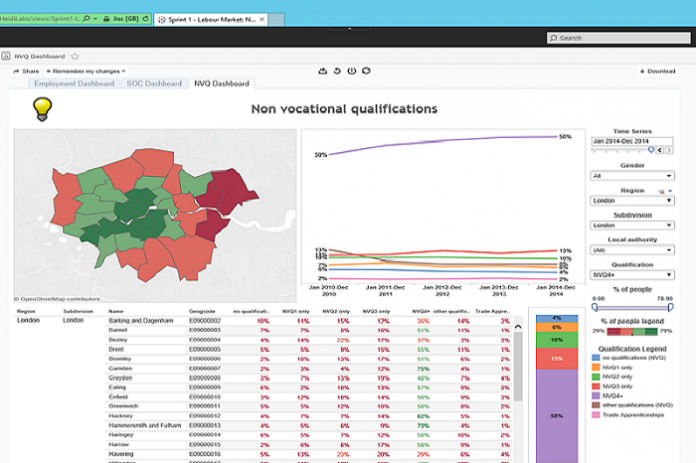The University of East London has been using data analysis to study widening participation trends and increase collaboration with boroughs in east London. Gary Tindell explains how UEL is applying these techniques at a national level as part of the Heidi Lab project sponsored by the Higher Education Statistics Agency and Jisc
Since 2002, the University of East London (UEL) has been carrying out a longstanding programme of research into localised patterns of higher education (HE) participation in East London and the emerging Thames Gateway region.
Although the majority of our research has focused on London and the South-East, it became clear that extending this approach to the rest of the UK would bring added value and would ideally complement the objectives of Jisc’s Heidi Lab project.
Heidi Lab is a national analytics research and development project, representing a first attempt at large scale cross institutional collaboration to create a series of business intelligence dashboards.
The Heidi project
It is part of a wider project that the Higher Education Statistics Agency (HESA) and Jisc are working on in partnership to develop a business intelligence shared service for UK education and research. The Heidi Lab project started in November 2015 and the outputs of the initial development cycle were presented at the HESPA 2016 annual conference and the Jisc Digital Festival 2016.
One of the key themes emerging from the first phase of the project and one that is continuing into the second development cycle is a focus on widening participation (WP) and the data that supports it. One of the projects is largely building upon the London based model but expanding this to include all of the UK as well as potentially integrating with other useful contextual data from national datasets.
We are combining a range of datasets to do this work including detailed HE participation data from HESA with School and College Performance, School Age Population Estimates, POLAR3, Index of multiple deprivation, skills levels and local labour market data to provide a much richer data context for analysts and researchers to interpret WP trends.
Surveying the WP landscape
At UEL we have been using data to examine our local WP landscape for some time. Our objective was to develop an academic strategy that aligned the UEL course portfolio with the emerging employment sectors across the Thames Gateway.
As part of the evaluation process, we repurposed HESA data for targeting WP and outreach activities. UEL also developed a KPI in conjunction with the Department for Communities and Local Government based on growth in student numbers to assess the impact of capital spending on higher education in the Thames Gateway.
One of the benefits of carrying on collecting this local HE data is that it fostered internal relationships within the university and in particular with our WP research centre led by Professor John Storan. The clustering of policy researchers around a longitudinal and evolving dataset has led to a series of external collaborations, most notably with the London borough of Newham and London Councils, the local government association for London.
Collaboration with councils
UEL began working in partnership with Newham in 2011 to examine the HE participation of their local residents and in particular, to determine what happened to local young people aged 16-19 educated outside the borough in neighbouring areas. The outcomes of this analysis resulted in a report that informed the business case for a substantial investment in a specialist STEM focused sixth form centre that opened in September 2014.
This collaboration with Newham has now evolved into a partnership with London Councils and the data coverage extended to cover all London boroughs. We’re now entering the fourth year of this partnership and an annual report is produced which examines the HE journey from pre-HE institutions, through their higher education study and into graduate employment. The findings of this report are disseminated widely across London and are used to brief:
- The investment in and returns from HE in London to political leaders;
- Regional reports presented to 14-19 education leads across the capital;
- Been used to inform investment decisions in 14-19 educational infrastructure;
- Borough level reports presented to Children and Young People Strategy Boards for the majority of London boroughs providing evidence ;
- Findings incorporated into the annual ‘Young People in London: an evidence base’ which is used extensively across London by education professionals;
- Report used by the London Enterprise Panel to inform thinking about European Social Investment Fund programmes;
- Findings used to raise London specific skills challenges and potential lobbying points within London and central government;
- Forms part of the evidence base submitted as part of the social mobility section of the HE Green Paper;
Interest in this application of data analysis is growing from a regional to a national and international level. We have exported this collaborative approach to Malmo in Sweden working in partnership with Malmo University and Municipality.








